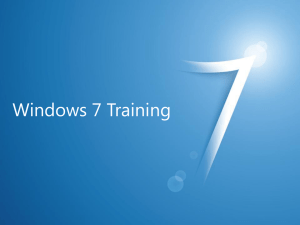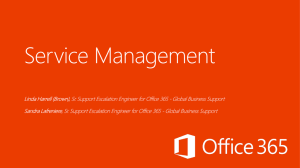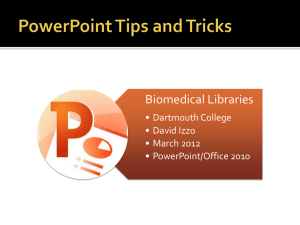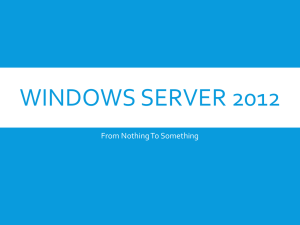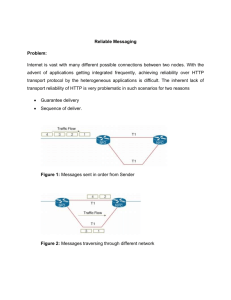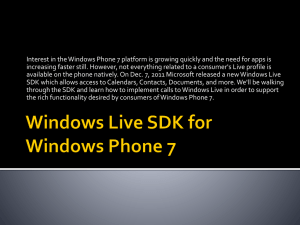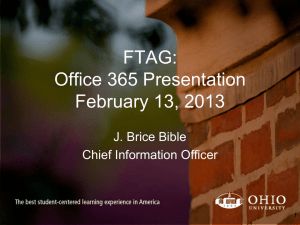Surface Computing
advertisement
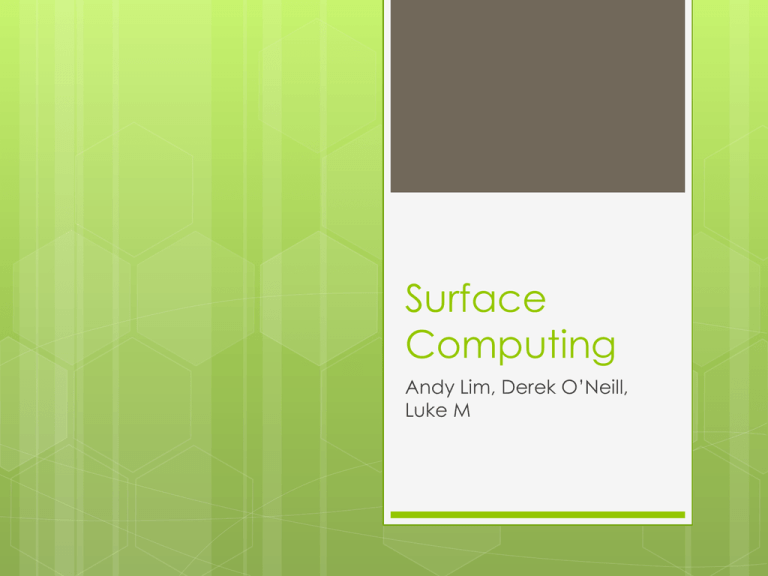
Surface Computing Andy Lim, Derek O’Neill, Luke M What is Surface Computing? A specialized computing GUI “Coffee Table” Surface Computing in the Works Microsoft Surface Codename Use “Milan” Cases Photo sharing Maps Menus Entertainment Much more! It is NOT just a Touch-Screen Object Oriented Multi-Touch Technology Device Interaction How does the Surface work? 1. Screen 2. Near IR light source 3. Near IR camera 4. Projector 5 5. PC FTIR: The DIY version What if you don’t want it cost $10,000 Fourier Transform Infrared Spectroscopy Embed IR LEDs in the plexiglass Things touching the surface of the screen scatter IR light towards the camera below What do we do with the picture? No preprocessing done by camera Raw data analyzed on PC and run through an edgedetection algorithm. Number of simultaneous inputs is only limited by surface area and computing power The Brains of the Surface Core 2 Duo 2GB DDR2 RAM 250GB SATA Hard drive ATI X1650 Video Card Windows Vista Optimized for 52 simultaneous inputs 4 people with all 10 fingers plus 12 objects What’s on the Surface Visual Marking Radio Signals Using the Cameras Recognizing Shapes Very Imprecise Algorithms for edge detection are expensive Developer must specify shapes in every program Mitigated if surface tells users what to put where, and then expects them to be there later Using the Cameras Tagging Series of reflective dots identify object and orientation Fairly cheap to process patterns Universal for the entire OS, no need to rewrite IDing code Requires tags be physically added to objects to interact with surface Uniquely tags objects with same shape Radio Signals RFID Use RFID tags to transmit information about what’s on the surface Lots of things already have RFIDs built in (credit cards, room keys) Surface needs to know what the data being received means RFIDs use backscattering, so the position of the object on the surface can’t be determined Radio Signals Bluetooth Bidirectional: Surface and Device interact with each other Relatively secure Can use Encryptable Devices Identify themselves Universal among mobile devices Limited to 7 devices connected No way to figure out position on the surface What’s on the Surface Visual Edge Marking detection on Items is great for finding positions of anything, but not great for identifying them Tagging requires an up front physical action, but results in an effective way to identify objects and where they sit Radio RFID Signals is a cheap, common way to transmit small streams of data, but its unidirectional Bluetooth allows bidirectional access, but it’s significantly more expensive Neither allow for items to be positioned on the screen What’s on the Surface Figuring out how to identify objects, grab their data, and correctly track the on the surface is a very difficult challenge in surface computing. Make the user tell you what something is when they place it Create a place for the user to put something and track it from there Tag objects, identify them at runtime and then follow the tag rather than the object Microsoft is currently working on technology to match RFID tags with physical objects based on when the tag is read and what’s placed on the surface Resources RFID Design http://www.das-labor.org/trac/export/3038/rfid-hacking/doc/RFID-CoilDesign.pdf http://consultingblogs.emc.com/richardwand/archive/2008/11/27/waiting-formicrosoft-surface-to-seamlessly-recognise-and-communicate-with-devices.aspx Tagging http://msdn.microsoft.com/en-us/library/ee804823%28v=Surface.10%29.aspx http://msdn.microsoft.com/en-us/library/ee804885%28v=Surface.10%29.aspx http://msdn.microsoft.com/en-us/library/ee786833%28v=Surface.10%29.aspx http://msdn.microsoft.com/en-us/library/ee804748%28v=Surface.10%29.aspx Bluetooth http://www.bluetooth.com/English/Technology/Pages/default.aspx http://www.sysopt.com/features/network/article.php/3532506 Research http://research.microsoft.com/en-us/um/people/merrie/surface_research.html Home of the Surface http://www.microsoft.com/surface/en/us/default.aspx
